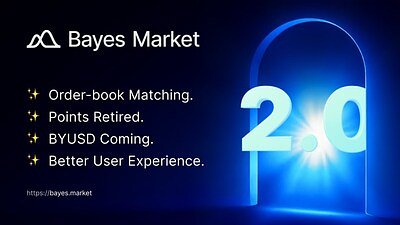
Bayes Market Bets on Institutional Investors with New Prediction Platform Upgrade
Bayes Market launches a major platform overhaul, including a stablecoin and central limit order book, aiming to attract institutional players to the nascent prediction market space. But key details remain elusive.
Bayes Market Bets on Institutional Investors with New Prediction Platform Upgrade
HONG KONG – Bayes Market, a relatively new platform aiming to quantify uncertainty through prediction markets, announced a significant upgrade this week, introducing a native stablecoin (BYUSD) and transitioning to a central limit order book (CLOB) structure. The move signals an ambition to attract institutional investors and mature a sector often dominated by speculative trading. However, a deeper look reveals a lack of readily available information about key aspects of the upgrade and the company itself.
Launched in June 2025, Bayes Market allows users to trade on the outcomes of events spanning economic, political, and social dimensions. The company asserts its platform “hedges every uncertainty” by providing a space to interpret and price potential outcomes. This latest upgrade, according to the press release, will enhance data integrity, improve price discovery, and expand coverage to include Asian and regional markets.
A Bid for Legitimacy: The CLOB & BYUSD
The move to a CLOB structure is particularly noteworthy. Unlike many existing prediction markets which rely on decentralized, often less liquid exchanges, a CLOB mimics the order book found in traditional financial markets. This aims to provide greater price transparency, tighter spreads, and the ability for larger, more sophisticated traders to participate. “The CLOB is a critical step in maturing the prediction market space,” says one anonymous market analyst. “It provides the infrastructure needed for institutional investors to comfortably allocate capital.”
Alongside the CLOB, the introduction of BYUSD, a native stablecoin, is intended to streamline transactions and provide a consistent unit of account. Stablecoins, pegged to a reserve asset like the US dollar, are designed to mitigate the price volatility often associated with cryptocurrencies, making them more appealing for mainstream adoption. However, detailed information about the backing of BYUSD, its auditing process, and regulatory compliance remains scarce. “Without transparency on the reserves supporting the stablecoin, it’s difficult to assess the risk involved,” notes a financial technology expert who requested anonymity. “The regulatory landscape for stablecoins is also evolving rapidly, and any new entrant needs to navigate that carefully.”
Expanding Beyond the US – A Risky Bet?
The company also announced plans to expand its event coverage beyond US-centric themes to include Asian and regional markets. While this demonstrates ambition, the specific markets targeted and the company’s understanding of local dynamics remain unclear. Expanding into new territories introduces complexities around data acquisition, regulatory compliance, and cultural nuances.
A Ghost in the Machine? Limited Public Data
Despite the ambitious upgrade, Bayes Market remains somewhat of an enigma. Our research uncovered limited public information about the company’s funding, user base, or trading volume. Neither Crunchbase nor PitchBook contain data on Bayes Labs Limited, suggesting the company may be in its early stages or operating privately. Attempts to find website traffic data on platforms like Similarweb and SEMrush were also unsuccessful.
This lack of transparency raises questions about the platform’s traction and viability. Without verifiable user metrics or financial data, it’s difficult to gauge the demand for Bayes Market’s services or its ability to compete in a burgeoning, yet still nascent, prediction market space.
“It's not uncommon for early-stage companies to be somewhat opaque,” says an anonymous venture capital investor specializing in fintech. “But in a space like prediction markets, where trust and transparency are paramount, a lack of publicly available information can be a red flag.”
The Competition Heats Up
Bayes Market isn’t operating in a vacuum. Competitors like Polymarket and Augur offer decentralized prediction markets with varying degrees of liquidity and features. Polymarket, for instance, allows users to trade on a wide range of events using USDC, a well-established stablecoin. Augur, while older, leverages blockchain technology to create a decentralized, trustless platform.
Bayes Market’s differentiator appears to be its focus on attracting institutional investors through a more sophisticated trading infrastructure. However, whether that strategy will succeed remains to be seen. “The challenge will be to balance the appeal to institutional players with the decentralized ethos that many prediction market enthusiasts value,” says an anonymous trader active in the space.
Looking Ahead: Questions Remain
Bayes Market’s upgrade represents a bold attempt to elevate the prediction market space. The introduction of a CLOB and stablecoin could potentially attract larger investors and improve liquidity. However, the lack of publicly available information about the company’s funding, user base, and the backing of its stablecoin raises concerns.
Investors and potential users will be watching closely to see if Bayes Market can deliver on its promises and establish itself as a leading player in this rapidly evolving market. Until more transparency is provided, caution is advised. The platform’s ambition is undeniable, but its success remains a question mark.
